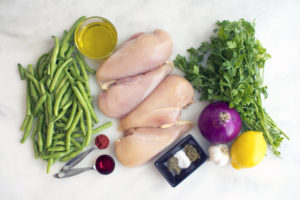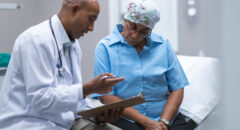
You’ve heard a lot about COVID-19—aka coronavirus, and who is at risk of severe illness from the virus. But it might surprise you to know that the same people who are at risk for severe illness from COVID-19, are also at risk for severe illness from food poisoning. Foodborne illness or food poisoning can affect anyone who eats food contaminated by bacteria, viruses, parasites, toxins, or other substances. However, adults age 65 and older, people with weakened immune systems due to illness or underlying medical conditions ( i.e., diabetes, kidney disease, HIV/AIDS), and pregnant women are more likely to get sick and have a more serious illness from food poisoning.
People with weakened immune systems cannot fight germs and sickness effectively. For example, nearly half of people 65 and older with foodborne illness are hospitalized. And people on dialysis are 50 times more likely to get foodborne illness from the listeria bacteria. Pregnant women are ten times more likely to get a listeria infection.
Currently, there is no evidence of food or food packaging being associated with the transmission of COVID-19. However, it is always important to keep food safety in mind. After all, you can't see, smell, or taste harmful bacteria that may cause illness.

The FDA recommends the following four food safety steps—clean, separate, cook, and chill, to keep you and your family safe from foodborne illness.
Clean: Wash hands and surfaces often
- Cleaning removes dirt, and sanitizing reduces the number of bacteria. Regularly clean and sanitize kitchen counters using a commercially available disinfectant product or a DIY sanitizing solution with 5 tablespoons (1/3 cup) unscented liquid chlorine bleach to 1 gallon of water or 4 teaspoons of bleach per quart of water. Do not use this solution or other disinfecting products on food.
- Wash hands for 20 seconds with soap and water before, during, and after preparing food and before eating.
- Wash your utensils, dishes, and cutting boards with hot, soapy water.
- Rinse fresh fruits and vegetables under running tap water, including those with skins and rinds that are not eaten. Scrub firm produce with a clean produce brush.
- With canned goods, remember to clean lids before opening.
- If you carry items home in reusable bags, make sure to wipe them down thoroughly or wash them immediately after returning home.
Separate: Separate raw meats from other foods
- Raw meat, poultry, seafood, and eggs can spread germs to ready-to-eat foods—unless you keep them separate.
- Use separate cutting boards and plates for raw meat, poultry, and seafood.
- When grocery shopping, keep raw meat, poultry, seafood, and their juices away from other foods.

Cook: Cook to the right temperature
- Food is safely cooked when the internal temperature gets high enough to kill germs that can make you sick. The only way to tell if food is safely cooked is to use a food thermometer. You can’t tell if food is properly cooked by checking its color and texture.
- Temperatures between 160°F to 212°F will kill most bacteria. Lower temperatures betweenn140°F and 159°F prevent their growth, but bacteria may survive.
- The Safe Minimum Cooking Temperatures Charts provides guidance on cooking and rest time for meat, poultry, seafood, and other cooked foods.
Chill: Refrigerate foods promptly
- Keep your refrigerator at 40°F or below and the freezer temperature at 0° F or below. Twenty-three percent of consumer refrigerators aren't cold enough. To ensure proper temperature, place a refrigerator thermometer inside the refrigerator on the middle shelf.
- Perishable food should be refrigerated within 2 hours. If the outdoor temperature is above 90°F, refrigerate within 1 hour.
- Thaw frozen food safely in the refrigerator, cold water or in the microwave. Never thaw foods on the counter, because bacteria multiply quickly in the parts of the food that reach room temperature.
- Divide large amounts of leftovers into shallow containers for quicker cooling in the refrigerator.
Food safety is also essential when it comes to shipped meal kits, food delivered by a local service, or takeout. This includes food arriving at a safe temperature to prevent the growth of bacteria that could make you sick. Bacteria can multiply rapidly if food is kept in the “danger zone” between 40°F and 140°F for more than two hours. Remember, you can't see, smell, or taste harmful bacteria that may cause illness.
 Constance Brown-Riggs, is a registered dietitian, certified diabetes educator, national speaker and author of the Diabetes Guide to Enjoying Foods of the World, a convenient guide to help people with diabetes enjoy all the flavors of the world while still following a healthy meal plan. Follow Constance on social media @eatingsoulfully
Constance Brown-Riggs, is a registered dietitian, certified diabetes educator, national speaker and author of the Diabetes Guide to Enjoying Foods of the World, a convenient guide to help people with diabetes enjoy all the flavors of the world while still following a healthy meal plan. Follow Constance on social media @eatingsoulfully







